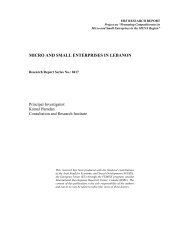View - ResearchGate
View - ResearchGate
View - ResearchGate
Create successful ePaper yourself
Turn your PDF publications into a flip-book with our unique Google optimized e-Paper software.
1. Introduction<br />
Discussion about the relationship between growth and growth volatility is old and important.<br />
Although growth theory has been studied independently of business cycle theory for a long<br />
time, there has been growing interest in linking these two areas (Ramey and Ramey, 1995).<br />
The observed high volatility— especially in developing countries— has led economists to<br />
focus on understanding the relationship between growth and growth volatility. Neither<br />
theoretical nor empirical studies, however, have provided conclusive results. This study<br />
analyzes the effects of growth volatility on growth and contributes to the literature by<br />
focusing on how growth volatility affects a set of variables that are crucial for growth in<br />
Turkey — a developing country suffering from high growth volatility.<br />
Different macroeconomic theorists have argued that output volatility has no effect, a positive<br />
effect, and a negative effect on output growth. Firstly, Friedman (1968) implicitly argues that<br />
fluctuations of output around a non-stochastic trend are independent of each other and that<br />
the fluctuations are caused by price misperceptions resulting from monetary shocks. In other<br />
words, the output growth rate is determined by real factors such as labor skills and<br />
technology. Speight (1999) provides empirical evidence that output volatility has a positive<br />
but insignificant effect on output growth rate.<br />
Secondly, a positive effect of output volatility on growth can be justified by the argument that<br />
volatility is associated with recessions, which lead to higher research and development<br />
spending and/or the destruction of the least productive firms. This is the “creative<br />
destruction” view, which dates back at least to Schumpeter (1939). Shleifer (1986), Caballero<br />
and Hammour (1994), and Aghion and Saint-Paul (1998) support this idea. Another argument<br />
for a positive effect is that more income volatility (uncertainty) leads to a higher savings rate<br />
(Sandmo, 1970) for precautionary reasons, and hence, a higher equilibrium economic growth<br />
rate. Black (1987) provides yet another argument for a positive effect, arguing that<br />
investments in risky technologies occur only if the expected return on such investments<br />
(average rate of output growth) is large enough to compensate for the extra risk. Kormendi<br />
and Meguire (1985), Grier and Tullock (1989), Caporale and McKiernan (1996, 1998), and<br />
Grier et al. (2004) provide empirical support for a positive relationship.<br />
Thirdly, a negative impact of output volatility on growth can be justified with the theoretical<br />
underpinnings going back to Keynes (1936), who argues that entrepreneurs, when estimating<br />
the return on an investment, consider fluctuations in economic activity. Output fluctuations<br />
increase the perceived riskiness of investment projects and thus lower the demand for<br />
investment, which in turn reduces output growth. The literature on sunspot equilibria<br />
(Woodford, 1990) obtains a similar result.<br />
Theoretical analyses suggest that if investments cannot be reversed, then increased volatility<br />
may lead to lower investment (Bernanke, 1983; Pindyck, 1991; and Aizenman and Marion,<br />
1993.) Ramey and Ramey (1991) argue that if firms must commit to their technology in<br />
advance, then volatility could lead to lower mean output because these firms find themselves<br />
producing at suboptimal levels ex post. If lower current output affects the accumulation of<br />
resources, then growth is adversely affected.<br />
A negative relationship between volatility and growth could also be caused by a tie between<br />
recessions and a worsening of financial and fiscal constraints. Such ties are more likely to<br />
occur in developing countries. If such ties exist, recessions can lead to less human capital<br />
development (a decrease in learning-by-doing, for instance), fewer productivity-enhancing<br />
expenditures, and thus lower growth rates (see Martin and Rogers, 1997; and Talvi and Vegh,<br />
2000). Other reasons to expect volatility to have a negative effect on growth are political<br />
insecurity (Alesina et al.; 1996), macroeconomic instability (Judson and Orphanides; 1996),<br />
2

















